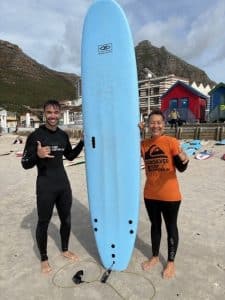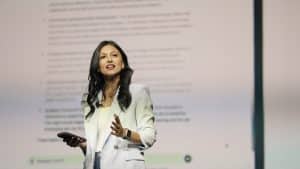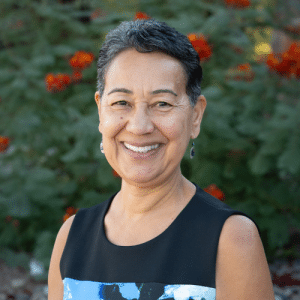My Learning Journey with AI
CompetencyWorks Blog
I recently designed a custom tank top to commemorate my experience learning to surf. Using DALL·E, I generated an image of a surfer awaiting waves with the phrase “Be Patient” overlaid. As I gazed at my tank top emblazoned with a commemorative AI-generated drawing of a surfer, I marveled at the progress I had made in just a year in my journey to become more informed about generative artificial intelligence (AI).

This journey had not only spurred learning about AI, but had also shifted my mindset as to what I was capable of exploring, experimenting with, and accomplishing. Not only did I explore AI platforms, but I was also emboldened to learn to surf, and then produce a custom-made garment to wear, proclaiming that accomplishment! So, come along with me on this “fantastic voyage…”
A year ago, in March 2024, it seemed as if every LinkedIn post I encountered or conversation I had with educators referenced the rapid advancement of AI. As I contemplated this ever-evolving technological landscape, I realized that I didn’t fully understand AI’s implications – let alone its potential impact on education. I decided it was time to explore. This blog post traces my year-long journey into AI, my efforts to move beyond the hype, and my critical assessment of AI’s applications in education.
Early Experiences and Eye-Opening Moments

When I first considered how to immerse myself in AI, an opportunity arose to join a professional learning community focused on creating AI tools via Playlab AI. The philosophy of playful experimentation in a lab-like environment was compelling. The journey was designed to be engaging, with built-in feedback opportunities and a manageable scope – allowing me to focus on developing just one AI tool for an authentic instructional challenge. The intuitive platform and camaraderie among participants made the experience even more rewarding.
Having gained a foundational understanding of AI, I attended webinars and AI bootcamps (thanks to organizations such as AI for Education). I then discovered 100 Days of AI via LinkedIn and dove in. This initiative from the organization 100 School offered daily 30-minute lessons on various AI platforms, helping me develop practical skills – such as using AI for research and creative work – culminating in a series of real-world design challenges.
Suddenly, I had a much deeper appreciation for AI’s ability to blur the lines between human creativity and machine-generated content. My experimentation led to deeper questions: Should AI-generated content be flagged for transparency? Where does AI assistance end and outright AI creation begin? As I used writing platforms like Sudowrite, I pondered the implications for human writers – what does it mean when AI can generate compelling content that authors might incorporate into their work?
Another pivotal moment occurred while reading Ethan Mollick’s Co-Intelligence: Living and Working With AI. He demonstrated how AI could mimic his writing style so convincingly that, had he not disclosed it, I wouldn’t have known which paragraph in his book was AI-generated.
While 100 Days of AI provided an engaging introduction, I craved a more systematic exploration of AI’s history and applications. Fortunately, Dr. Sabba Quidwai, CEO of Designing Schools, offered me access to her AI bootcamp. This self-paced program emphasizes design thinking’s role in ensuring AI enhances–rather than replaces–human intelligence. I highly recommend her book, Designing Schools: How Design Thinking Makes You Irreplaceable in the Age of AI.

Hands-On AI Experimentation: Small But Impactful Steps
While learning about AI was personally enriching, I wanted to share my journey with others. I began by introducing AI to colleagues in small, practical ways. For example, I helped a teacher brainstorm physical education activities using ChatGPT–generating fresh ideas she hadn’t considered. Another colleague, frustrated by information overload, discovered how AI-powered summarization tools could streamline his workflow. These experiences reinforced an important lesson: meeting people where they are and gradually introducing AI in a way that aligns with their needs.
Just as important as AI’s capabilities are its limitations. I stress to colleagues that AI outputs must be critically evaluated. Additionally, I caution against uploading sensitive information, as data security remains a concern with many AI platforms.
Emerging Concerns: AI’s Limitations and Ethical Challenges
My hands-on experience quickly revealed AI’s limitations. I encountered outdated or incorrect information and saw firsthand how AI’s hallucinations–instances where AI generates false or misleading content–could be problematic. I was also disheartened by bias in AI models, which remains a significant concern and requires ongoing vigilance. For example, when trying to generate images of a medical doctor, AI would only produce images featuring white male physicians.
I also became aware of AI’s environmental impact. The immense computing power required for AI operations consumes significant resources, particularly the water used to cool data centers. This raises critical sustainability questions that should be an integral part of the AI conversation.
Another growing concern is the uneven access to AI tools. While some students and educators readily adopt AI, others are restricted due to technological limitations or school policies. Additionally, some students worry that AI will take over the creative tasks they enjoy. These fears are indeed valid. However, rather than banning AI, we should equip students and educators with critical thinking skills to assess and navigate AI’s risks and opportunities effectively. Recommended actions for ethical AI interaction include:
- Prioritizing teaching AI literacy, including understanding how AI systems work, and striving to recognize the difference between AI-generated content and human-created work.
- Establishing clear policies around AI acquisition and use.
- Understanding the importance of data privacy and security when interacting with AI tools.
- Using AI for creative and analytical tasks while also maintaining originality.
- Staying informed about AI advancements and developing a mindset oriented to continuous learning to keep up with AI’s evolution.
Moving Forward: Embracing AI While Staying Cautious

At first, I really embraced all things AI. Now I take a more balanced approach to AI – leveraging it for efficiency and innovation while remaining mindful of its risks. As mentioned at the outset of this post, one of my recent AI experiments involved custom designing apparel. This experience gave me a personalized reminder of perseverance and the need to prioritize patience when learning something new.
I have also explored AI agents through 100 School and completed a seven-day course on learning more about AI Agents. These agents are autonomous or semi-autonomous systems that can look, listen, and make decisions on their own, to achieve specific goals. They can be software-based, such as chatbots, or embodied in things like robots or self-driving cars. The AI agent I created emails me five vegetarian slow cooker recipes every Thursday – simplifying my meal planning. Additionally, I have used Notebook LM to convert my reflections on the 100 Days of AI challenge into a podcast format, making the content accessible to friends who prefer audio over text.
Final Thoughts: The Road Ahead
One of the most surprising aspects of my AI journey has been coming to terms with the staggering pace of development. New capabilities emerge weekly, making it exhilarating yet challenging to keep up. At times, staying current with both AI’s possibilities and its ethical implications feels like a full-time job.
So what’s next? I’ve decided to continue learning at a pace that works for me – critically evaluating AI’s outputs while embracing its efficiencies. More importantly, as a lifelong educator, I aim to explore how AI can support personalized learning while ensuring that human creativity and decision-making remain at the center. Thus a key question moving forward is: How can AI help us build more customized learning pathways for students while preserving the essential role of human educators? Finding that balance will define the future of AI in education. I look forward to continuing this exciting learning journey!
Learn More
- An AI Design Sprint: A Glimpse into the Future of Education
- Busting Barriers with AI
- Generative AI & The Future of Learning
 Loretta Goodwin, Ph.D. was the Aurora Institute’s Chief Operating Officer, overseeing programmatic work, talent development, DEI work, and supporting implementation of the strategic plan. Prior to joining Aurora, Dr. Goodwin was the Deputy Director at the American Youth Policy Forum, focused on promoting equitable education for all young people. An educator and lifelong learner at heart, she has worked consistently in the fields of education to transform learning opportunities for young people.
Loretta Goodwin, Ph.D. was the Aurora Institute’s Chief Operating Officer, overseeing programmatic work, talent development, DEI work, and supporting implementation of the strategic plan. Prior to joining Aurora, Dr. Goodwin was the Deputy Director at the American Youth Policy Forum, focused on promoting equitable education for all young people. An educator and lifelong learner at heart, she has worked consistently in the fields of education to transform learning opportunities for young people.